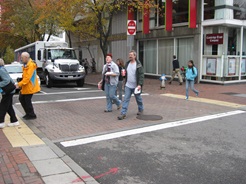Pedestrian Safety

There are many design considerations for pedestrian safety whenever a road is reconstructed. Designing intersections to minimize crossing distances and vehicle speeds, while maximizing visibility are priorities whenever roads are reconstructed. Tightening corners can slow down turning vehicles, making an intersection safer for pedestrians. Curb extensions can serve several purposes—they reduce turning speeds, eliminate illegal parking within twenty feet of an intersection, make pedestrians more visible to vehicles, and reduce pedestrians’ crossing distance.
Crosswalks must be well marked so that they are highly visible, day and night, to drivers and cyclists. Cambridge’s preference is for zebra-striped crosswalks. There need to be enough crosswalks that pedestrians do not have to go very far out of their way to use them on busy streets.
The slower traffic moves, the safer the street is for pedestrians. Slow-moving vehicles are less likely to hit pedestrians, and if they do, the injuries pedestrians suffer are less severe. Currently the state’s default speed limit in built-up areas, which includes all of Cambridge, is 30 miles an hour. The City has joined with many other groups to call for a reduction of the speed limit to 25 mph to make it even safer for bikers and pedestrians. Ultimately, the goal should be a city of neighborhoods where children can travel freely. Likely because people are not able to drive as fast as they can elsewhere in the country, the metropolitan Boston area has been ranked as the safest for travel.
The City’s traffic calming program received a national award from the Partnership for a Walkable America and the Institute of Transportation Engineers, because it is designed to benefit pedestrians. Since 1997, when the program began, many traffic calming measures have been installed throughout the city.
Getting Along out There: Education and Enforcement
Educating adults and children on the rules of the road is an ongoing process. Drivers typically do not take out the instruction manual again after they get their license and are often unaware of how they are required to behave around pedestrians and cyclists. Many cyclists are not taught correctly or misunderstand how to ride safely. Pedestrians often jaywalk, expecting that motorists and cyclists will see them in time to stop safely, which is not always the case.
Key to pedestrian safety is enforcement of vehicles’ failure to yield, red-light running, and speeding. Periodically, the police do "spot enforcement" of motorist and cyclist failure to yield in crosswalks, though not frequently or regularly. For pedestrian safety, it is important that motorists and cyclists obey the law and stop at crosswalks.
City publications include safety information and reminders of the rules, and schools have safety training for children. More can be done. It is challenging to get and hold people’s attention around safety issues.
For More Information
For more information, contact the Environmental and Transportation Planning Division at 617/349-4600.